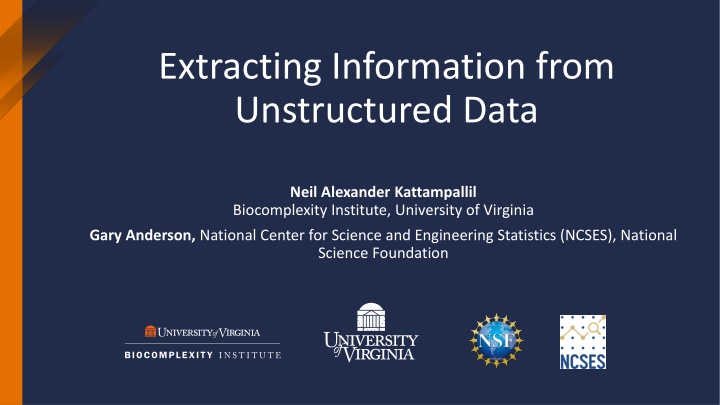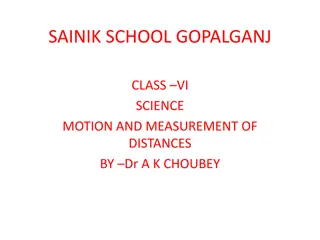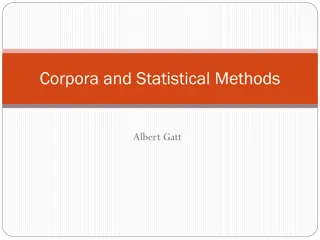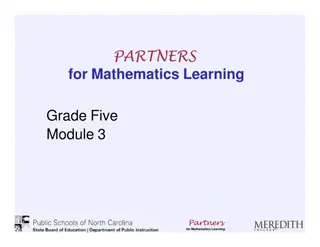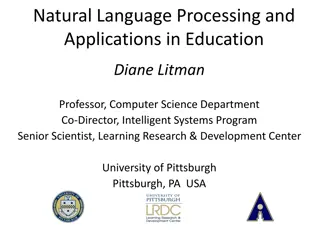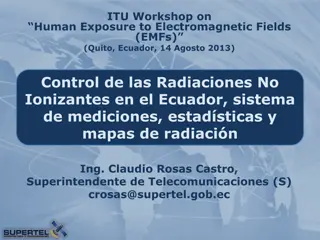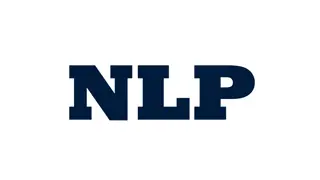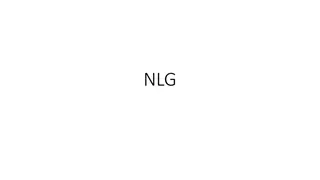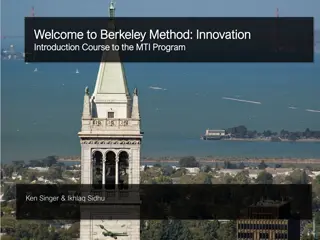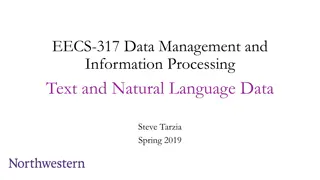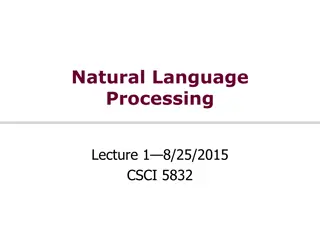Enhancing Business Innovation Measurement Using Natural Language Processing
Explore the use of alternative data sources and advanced methods like natural language processing and machine learning to enhance the measurement of business innovation. Focus on acquiring richer innovation measures from non-survey data, such as product announcements and financial filings. Assess the feasibility of complementing traditional survey-based innovation metrics. Specifically, target product innovation in sectors like pharmaceuticals, food processing, and computer systems design, utilizing news articles as primary data sources.
Download Presentation

Please find below an Image/Link to download the presentation.
The content on the website is provided AS IS for your information and personal use only. It may not be sold, licensed, or shared on other websites without obtaining consent from the author.If you encounter any issues during the download, it is possible that the publisher has removed the file from their server.
You are allowed to download the files provided on this website for personal or commercial use, subject to the condition that they are used lawfully. All files are the property of their respective owners.
The content on the website is provided AS IS for your information and personal use only. It may not be sold, licensed, or shared on other websites without obtaining consent from the author.
E N D
Presentation Transcript
Extracting Information from Unstructured Data Neil Alexander Kattampallil Biocomplexity Institute, University of Virginia Gary Anderson, National Center for Science and Engineering Statistics (NCSES), National Science Foundation
Current Measure of Innovation EuroStat: Community Innovation Survey Conducted every 2 years by EU member states and ESS member countries Survey of innovation activity by enterprises Annual Business Survey (US Census Bureau and NSF/NCSES) Collects data on R&D, innovation, technology, intellectual property, and business owner characteristics Annual; initial year: 2018 Previously, Business R&D Innovation Survey (BRDIS) launched in 2009 Annual Business Survey (ABS) question on innovation
Background and Goals Can we use alternative (non-survey) data sources to measure business innovation? While ABS measures innovation incidence, i.e., the number of innovating firms, we aim to test the feasibility of developing methods using non-traditional data to obtain richer and complementary innovation measures. We develop natural language processing and machine learning methods using non-survey data to obtain richer and complementary innovation measures. Focus on opportunity and administrative data (e.g., product announcements, press releases, financial filings). What type(s) of innovation or improvement (i.e., greater efficacy, resource efficiency, reliability and resilience, affordability, convenience and usability) could be captured using opportunity data sources? How does it vary across different companies and sectors?
Current Focus Innovation Type: Product innovation as defined by the OSLO Manual Sectors: Pharmaceutical and Medicine Manufacturing (NAICS 3254) Food Processing & Beverage Manufacturing (NAICS 311 & 3121) Computer Systems Design and Related Services (NAICS 5415) A product innovation is a new or improved good or service that differs significantly from the firm s previous goods or services and that has been made available to potential users. Data Sources: News articles Innovation Metrics: Number of new products/launches by company & measures of novelty of innovation Validation: Comparison of extracted metrics to ground-truth data and computation of performance metrics to evaluate methods Repeatability: Applying these data and methods to other sectors?
Data Sources Pharma Articles by Company (2015) News articles from Dow Jones Data, News, and Analytics (DNA) database Regulatory Agencies Companies English language Articles between 2013 and 2021 Region Code USA Variables: company_codes, subject_codes, region_codes, word_count Additional DNA Subject Codes that can be used to further improve data selection, e.g., c22 New Product/Service Sector Pharma Articles by Publisher (2015) Number of articles Pharmaceutical and Medicine Manufacturing (NAICS 3254) 1.8 M (2013 - 2018) Data Obtained Food Processing & Beverage Manufacturing Sectors (NAICS 311 & 3121) 600 K (2013 - 2021) Computer Systems Design and Related Services (NAICS 5415) 1.2 M (2013 - 2021)
Unstructured Text Data : An Overview Any information that doesn t follow conventional data models, making it difficult to store and manage in a Relational Database. Word Documents Emails Social Media posts Medical notes (Healthcare NLP) Most of this exists as dark data , data that is collected by an organization which is not used for analytics or insight generation, and is usually stored only for compliance purposes.
Methods: BERT A pre-trained unsupervised Natural Language Processing model developed by Google in 2018 Image Attribution: Bert; Sesame Workshop
BERT Benefit Pre-trained models solve challenge of lack of enough training data Can use pre-trained models to fine tune on smaller-task specific datasets and improves accuracy drastically Book Corpus: 2,500 million words Wikipedia: 800 million words BERT Explained: A Complete Guide with Theory and Tutorials
Semantic Similarity Language models like BERT are based on training with large data sets, such as: full text of Wikipedia Open Books corpus The goal is to develop a vector representation of words, in a given sentence that represent a given idea. These Language models contain vector representations of words, clustered by similarity of ideas in an n-dimensional vector space.
Named Entity Recognition Named-entity recognition (NER), also known as (named) entity identification entity chunking, and entity extraction) This is a subtask of information extraction that seeks to locate and classify named entities mentioned in unstructured text into pre-defined categories such as person names organizations, locations medical codes time expressions quantities monetary values percentages, etc.
Categories for NER Normally, NER uses eight categories location, person, organization, date, time, percentage, monetary value, and none-of-the-above . NER first finds named entities in sentences and declares the category of the entity. In the sentence: Apple [organization] CEO Tim Cook [Person] Introduces 2 New, Lager iPhones, Smart Watch at Cupertino [Location] Flint Center [Organization] Event. Note that Apple is recognized as an organization name instead of a fruit name in terms of its context.
BERT NER models bert-base-NER is a fine-tuned BERT model that is ready to use for Named Entity Recognition and achieves state-of-the-art performance for the NER task. It has been trained to recognize four types of entities: location (LOC), organizations (ORG), person (PER) and Miscellaneous (MISC). Specifically, this model is a bert-base-cased model that was fine-tuned on the English version of the standard CoNLL-2003 Named Entity Recognition dataset.
BERT - Named Entity Recognition (NER) Identifies and categorizes entities into 4 categories based on the context that the words are used in Location, Person, Organization, Miscellaneous Tagging by huggingface model dlsim/bert-base- NER. Tokenizes words Craftsbury becomes Crafts## and ##bury Uses surrounding words (Sentence context) John works at _______. Is Case Sensitive Can be further fine-tuned by training on a corpus
BERT - Named Entity Recognition (NER) Use NER to extract organization names from the articles to identify company names Fuzzy Match (fuzzywuzzy) extracted names with DNA company names to evaluate NER
NER Company Name Extraction Performance Results for labeled data from 3 Sectors: Food & Beverage Pharma Software Total Number of Labeled Company Names: 32 129 232 Exact Matches: 12 36 112 Fuzzy Matches: 14 73 80 Total Matches: 26 109 192 Total Accuracy (%): 81% 84% 83% Labeled data is a random sample of articles across all available years, as mentioned in slide 10
Training for Additional Categories If there are custom categories that need to be extracted, we can use transfer learning to build on the existing categories that the model is trained for, and then add training data for new categories.
17 Applications of BERT: Named Entity Recognition https://towardsdatascience.com/named-entity-recognition- ner-with-bert-in-spark-nlp-874df20d1d77
Bert - Question and Answering (QnA) - BERT uses token embedding similarities to retrieve answers to a given question, from a given reference corpus of information. We use QnA to extract company and product names
QnA - Company and Product Extraction Pharma Product Company 284 284 Total Number of Labeled Names: 140 88 Exact Matches: 111 131 Fuzzy Matches: 251 219 Total Matches: 88.3% 77.1% Total Accuracy (%):
Thank you! Questions & Comments? Contact: Thomas Neil Alexander Kattampallil (nak3t@virginia.edu) Research Scientist Biocomplexity Institute, University of Virginia Acknowledgments: This material is based on work supported by U.S. Department of Agriculture (58-3AEU-7-0074) and the National Science Foundation (Contract #49100420C0015) Disclaimer: The views expressed in this paper are those of the authors and not necessarily those of their respective institutions.
